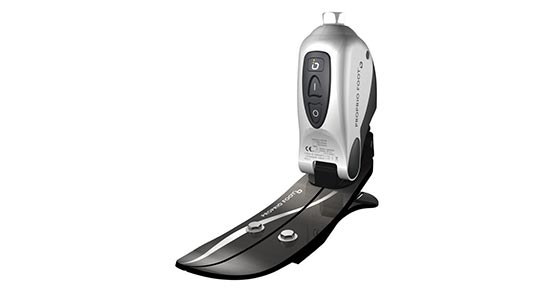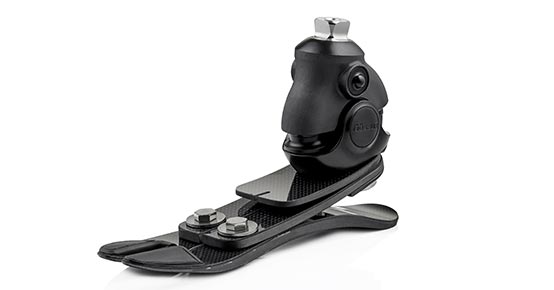Socket
Easily the most important part of your prosthesis that is manufactured to a custom molded model of the patient’s limb. It is vital that this critical component fits accurately and well, with a high degree of comfort and mobility.
Marlo Anatomical Socket (M.A.S.)
The M.A.S. design provides several clinical benefits: patients can sit more comfortably; there is no plastic beneath the gluteus; the prosthesis is easier to don; patients enjoy full range of motion, and better functional walking. Seeing a video of patients walking, sitting, and demonstrating the range of motion possible is truly amazing.
The suspension system
The suspension system holds prosthesis on the resdiual limb and enables easy put on (donning) and take off (doffing).
Vacuum suspension systems
The vacuum pump in this system evacuates air from the socket. It creates a negative pressure with every step which improves overall control of the prosthesis. Pressure on the residual limb is greatly reduced.
The SmartPuck™
a socket system with integrated elevated vacuum. The SmartPuck is an app controlled smart vacuum, designed to maintain a constant vacuum level within the socket. The system is self contained and is completely modular so it can be transferred from socket to socket.
The AirPuck™
Umodular socket vacuum reservoir that only has to be evacuated once and can maintain negative pressure with in the prosthetic socket all day long. AirPuck is ideal for water sports, and diagnostic fittings.
EchelonVAC by Endolite
Optimal socket connection is critical to an amputee’s comfort, security and stability. EchelonVAC quietly creates elevated vacuum, helping to maintain an optimally fitting socket throughout the day.
Shuttle lock suspension
In this case, you use a padded liner with a pin at the end. The pin is inserted into a shuttle lock built into the bottom of your socket, the only connection point. One variation for above-knee prostheses, called a lanyard system, uses a strap to pull the liner into the socket. The lanyard also connects the socket to the liner near the top, which slightly reduces rotation and shear.
Suction suspension
Also a common method of suspension for a transtibial prosthesis. A suction system consists of a soft liner, a one-way valve and a sealing sleeve. Inserting your liner-covered limb into the socket and applying body weight as you stand expels excess air through the valve
Knee
Friction is used in the knees in order to control the knee joint during walking. Friction controls how far and how fast the knee bends and straightens during walking. Some knees have mechanical friction while others have hydraulic resistance. Computerized knees are also available that control the knee speed based on the person’s walking. Mechanical knees provide constant friction where the hydraulic knees and computerized knees change the knee speed depending on how fast the person is walking.
Manual Locking Knee
The manual locking knee is the most stable knee used in prosthetics. The knee is locked during walking and the patient releases the lock mechanism in order to sit down. Manual locking knees are primarily used with patients who have very short residual limbs and/or poor hip strength and are unable to control the knee.
Hydraulic and Pneumatic Knees
Hydraulic and pneumatic knees allow adjustment of walking speed by the use of hydraulics (either liquid or air) within the knee. As a person’s walking speed increases or decreases, the hydraulics adjust to control the speed at which the shin of the prosthesis swings forward and bends backwards. This type of knee is often used for more active patients who vary their walking speeds and do not need assistive walking devices.
Total Knee by Össur
Designed for daily activities involving gentle, steady walking with the use of walking aid.
Microprocessor knees
All microprocessor controlled knees feature sensors, a microprocessor, software, a resistance system and a battery. The knee’s internal computer (microprocessor) controls an internal fluid, which may be hydraulic or pneumatic. The internal computer monitors each phase of your walking and control of fluid allows the processor to make adjustments in resistance, so you can walk more efficiently at various speeds and walk more safely down ramps and stairs.
Rheo knee by Össur
The Rheo knee - an optimal combination of stability and safety. It enables exceptionally natural and effortless walking, even on difficult terrain. The Rheo knee is easy to fit, and delivers reliable user outcomes.
C-Leg by Ottobock
C-Leg by Ottobock is weatherproof and offers enhanced stumble recovery feature, intuitive or automatic stance options, walking backward support and real time swing and stance control.
Genium and Genium X3 by Ottobock
The Genium is water-resistant, offers a powerful walk-to-run function, stepping right over the obstacles and walking up stairs step-over-step.
Orion3 by Endolite
Orion3 is suitable for K3 users who would benefit from stability on different terrains, slopes and steps. The knee system encourages users to evenly distribute their weight, offloading their sound side and lower back to reduce aches and pains commonly reported by amputees.
Ankle
In order to mimic the capabilities of an able-bodied, a powered prosthetic ankle for walking and running was designed. A powered system has the potential to reduce the limitations in range of motion and positive work output of passive walking and running feet. Adjustable ankle components for leg prostheses allow an amputee to modify the pitch angle of the foot. This significantly expands footwear options with differing heel heights.
Proprio Foot by Össur

Proprio Foot is an adaptive microprocessor controlled waterproof ankle for low to moderately active amputees. Motor-powered ankle motion increases toe clearance in swing phase by raising the forefoot, reducing the risk of trips and falls. It also adjusts the ankle angle to changing terrain, providing stable foot placement on stairs and inclined surfaces.
The BiOM Ankle
the only prosthesis with powered propulsion. It is characterized by the following clinically proven features: Energizes every step to walk farther and faster – even up ramps, hills and stairs, mimics physiological ankle movement and ensures a centered alignment and a more natural stride. By replacing the function of your lost muscles and tendons the bionic ankle can act as a biological ankle would. It restores a more natural walking than what you would experience with any other prosthesis. Designed for people with both below and above the knee amputations. Amputees find they are able to live life more independently, return to work, and improve overall quality of life.
Foot
A good prosthetic foot must be strong, as it is taking on huge force and torque as you walk and run. It must be light, small, and yet functional and durable. For those who are most active, a prosthetic foot must mimic a normal foot during the act of walking. It must act as a shock absorber as you strike your heel to the ground, adapt to uneven terrain, provide a smooth rollover from heel to toe, and provide a rigid lever for propelling forward when you finish your step.
In terms of function, prosthetic feet can be categorized into the following groups: Solid Ankle Cushioned Heel (SACH), Elastic (flexible) Keel Foot, Single-Axis Foot, Multi-Axis Foot, Dynamic-Response Foot, and Microprocessor Foot.
Our team will advise you what type of foot is optimal for your ambulation level.
SACH foot
A SACH foot typically has a rigid inner structure of wood or plastic, surrounded by a compressible foam cosmetic shell. The SACH (solid-ankle-cushioned-heel) foot's sturdy function is especially useful for individuals with lower activity levels.
Pro-Flex range by Össur
Pro-Flex LP Align combines functionality, comfort and aesthetic design. It allows users the freedom to choose footwear that best suits their activities, without having to compromise alignment, posture, dynamics or functionality. The heel height adjustment feature is quick and easy to use. The lightweight anatomical foot cover features a steady-grip sole for barefoot stability on wet or slick surfaces and a sandal toe to accommodate a range of footwear. The spaced sandal toe easily clamps onto sandals and flip-flops held by the toe.
The Pro-Flex LP Torsion

The Pro-Flex LP Torsion offers a high degree of ankle motion; a significant improvement in relation to conventional low-profile carbon fiber feet. It incorporates a effective full-length toe, and new ‘reverse tapered’ technology, allowing for greater upward flexion of the foot.
The Triton product line by Ottobock
The Triton product line by Ottobock offers a selection of prosthetic feet to meet the demands of highly active users. Their outstanding dynamic response and flexibility support mobility at the highest level – in everyday life and for recreational sports.
Echelon by Endolite
The Echelon carbon foot gives Level 3 amputees a hydraulic ankle control on ramps and stairs. It has an instant impact on postural symmetry, easing abnormal pressures at interface and other joints. Wearing echelon promotes stability and confidence on rough and sloping surfaces, reduces the number of falls plus it gives excellent energy response at all times.



